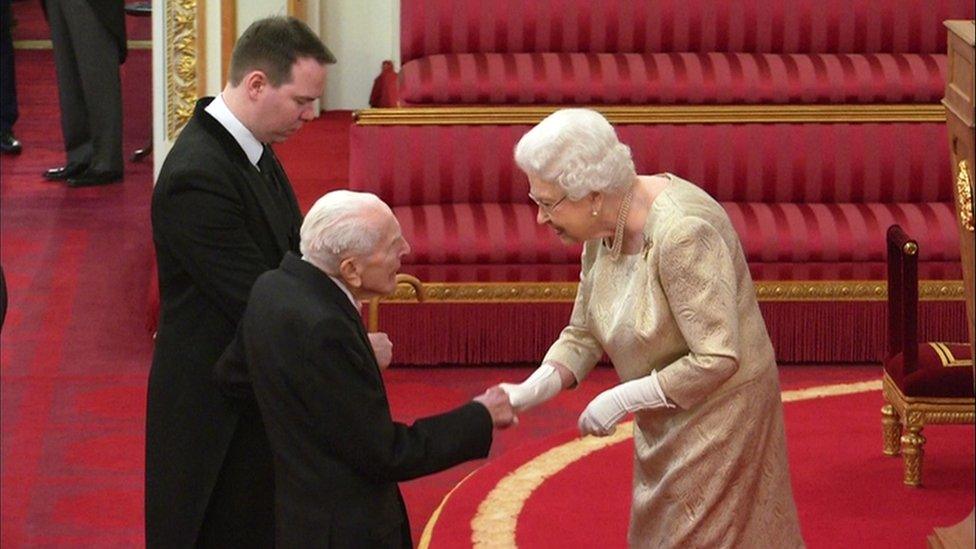British Normandy Memorial unveiled in France to honour D-Day and Normandy fallen
- Published
The memorial was unveiled on the 77th anniversary of the Normandy landings
A memorial honouring soldiers who died under British command on D-Day - and in the fighting that followed - has been unveiled in France on the 77th anniversary of the Normandy landings.
The British Normandy Memorial records the names of the 22,442 people who were killed on D-Day and at the Battle of Normandy.
It cost £30m and was designed by British architect Liam O'Connor.
Due to Covid restrictions, veterans watched the unveiling via video link.
Only a small number of people were able to attend the event in the Normandy town of Ver-sur-Mer, where the memorial is situated.
Around 100 veterans unable to travel to Normandy watched a live broadcast from the National Memorial Arboretum in Staffordshire.
At 11:00 BST the Last Post was played, ushering in a two-minute silence.
Meanwhile, British and French wreaths were placed in front of the D-Day Wall at the memorial in France as bagpipes played.
The RAF's Red Arrows and the French Air Force's Patrouille de France aerobatic teams then flew overhead to mark the opening of the memorial.
It remembers those who died in the largest seaborne invasion in history, as about 160,000 troops from Britain, the US, Canada, France and other Allied nations landed in Normandy.
This marked the beginning the liberation of France from the Nazis and paved the way for victory on the Western Front in World War Two.
Paul Harris said his grandfather, Private George Hanks, who died aged 30 on 7 August 1944 during the months of fighting that followed the D-Day landings, "gave up everything" to liberate Normandy and the rest of Europe.
Mr Harris told BBC Breakfast: "He went off to fight, he left my grandmother a widow with a young baby... He gave us what we have now and that memory has to be preserved."

British Piper Steve Black plays at sunrise to mark the 77th anniversary of D-Day at the British Normandy Memorial on Sunday
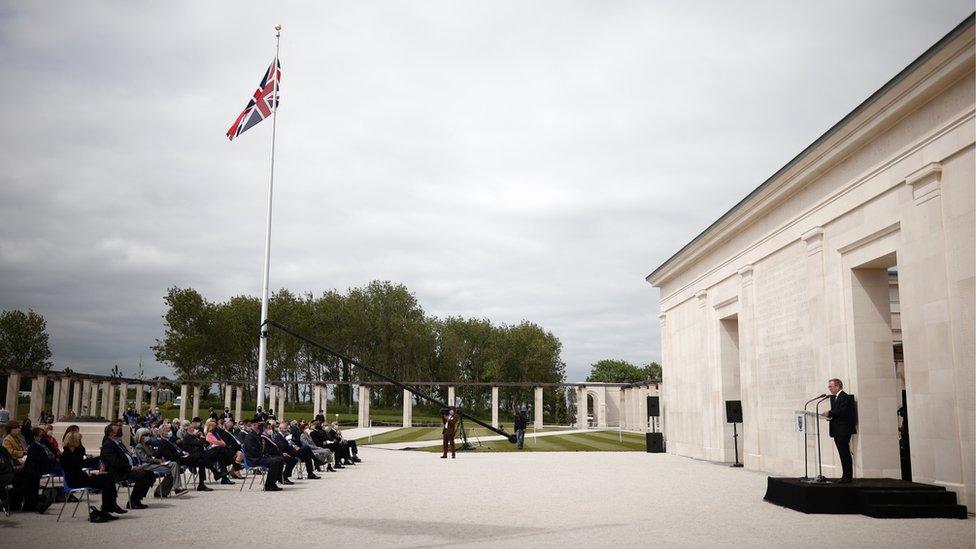
The British Ambassador to France, Lord Edward Llewellyn, spoke at the memorial in Normandy

The Prince of Wales spoke by video-link to about 100 veterans and their families gathered in Staffordshire
Private Hanks was killed by an artillery shell as his company pressed ahead towards German fortifications.
His family say that only the day before he had finally received a letter containing a picture of his baby girl, Rosemary - Paul's mother.
In a video message the Prince of Wales, patron of the Normandy Memorial Trust, said it was important the memory of these "remarkable individuals should be preserved for future generations as an example of personal courage and sacrifice, for the benefit of the wider national and, indeed, international community".
"I know just how much our incomparable veterans had hoped to be in Normandy today to see their memorial for themselves" he said.
"Despite having to watch via satellite link, this in no way obscures the enormous regard, and admiration, in which we hold our veterans - or diminishes our debt of gratitude to the more than 22,000 men and women whose names are now permanently inscribed in stone in this place of honour above Gold Beach."
'Eyes of the world'
Prime Minister Boris Johnson also paid tribute to those who fought on D-Day, recalling General Eisenhower's words that as they landed on the Normandy beaches "the eyes of the world were on them".
"The hopes and prayers of liberty-loving people everywhere marched with them. 77 years on, we thank and remember them," the prime minister said on Twitter, external.
Lord Edward Llewellyn, the British Ambassador to France, presided over the ceremony and was joined by Lord Peter Ricketts, chairman of Trustees at the Normandy Memorial Trust, and senior French guests.
The event also included coverage of the Royal British Legion's service of remembrance at the Bayeux Commonwealth War Graves Cemetery, and provided an opportunity for Normandy veterans to have their Legion d'Honneur formally presented to them by the French ambassador to the UK.
The memorial is the culmination of years of campaigning by D-Day veterans.
Its £30m cost was funded by the UK government, private donations and fundraising efforts by D-Day veterans like 94-year-old Harry Billinge, who was appointed MBE for raising more than £25,000 towards it.
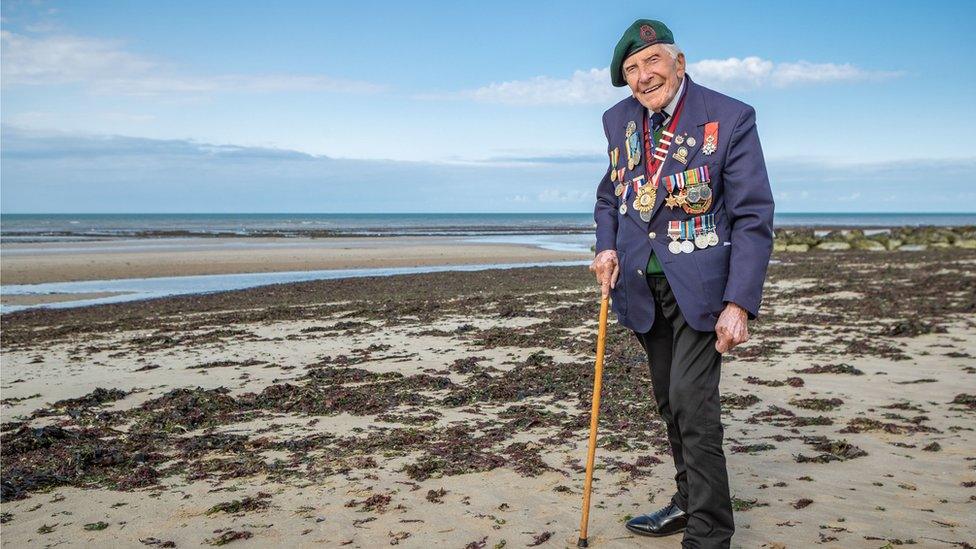
D-Day veteran Harry Billinge was appointed MBE for raising more than £25,000 towards the memorial
The 94-year-old from St Austell, Cornwall, said he was "overwhelmed" by the memorial and "had tears in my eyes".
"When I collect money for that memorial, I get a great calmness over me," he told the BBC.
"I lost a lot of good men, young men."
The memorial sits atop a hillside overlooking Gold Beach, one of three where soldiers landed on the morning of 6 June 1944.
The site consists of a temple-like structure containing 160 stone columns inscribed with the names of the dead, a bronze sculpture of three charging infantrymen by British sculptor David Williams-Ellis, and a wall featuring the names of those who were killed on D-Day itself.
Among those who lost their lives during D-Day and the Battle of Normandy are two women, both nurses: 27-year-old Sister Mollie Evershed and Sister Dorothy Anyta Field, 32.
Sister Evershed was on a Hospital Carrier ship, the Amsterdam, treating casualties from Juno Beach when the ship hit a mine.
As it sank, she and another nurse went below decks and carried 75 men to safety, helping them into a waiting lifeboat. But she and her fellow nurse went down with the ship.
She was posthumously mentioned in dispatches and awarded the King's Commendation for Brave Conduct.
The memorial also bears the name of Corporal Sidney Bates, awarded the Victoria Cross at the age of 23 for his extraordinary feat in holding Perrier Ridge in the face of an advance by two divisions including Panzer tanks.
Fearing his section would be overwhelmed, Corporal Bates - known as "Basher Bates - seized the Bren gun of a fallen comrade and charged forward, repeatedly rising to his feet again after being shot three times.
Even after a mortar brought him down, eyewitnesses said he continued firing from the ground, eventually forcing the enemy to retreat. He died two days later.
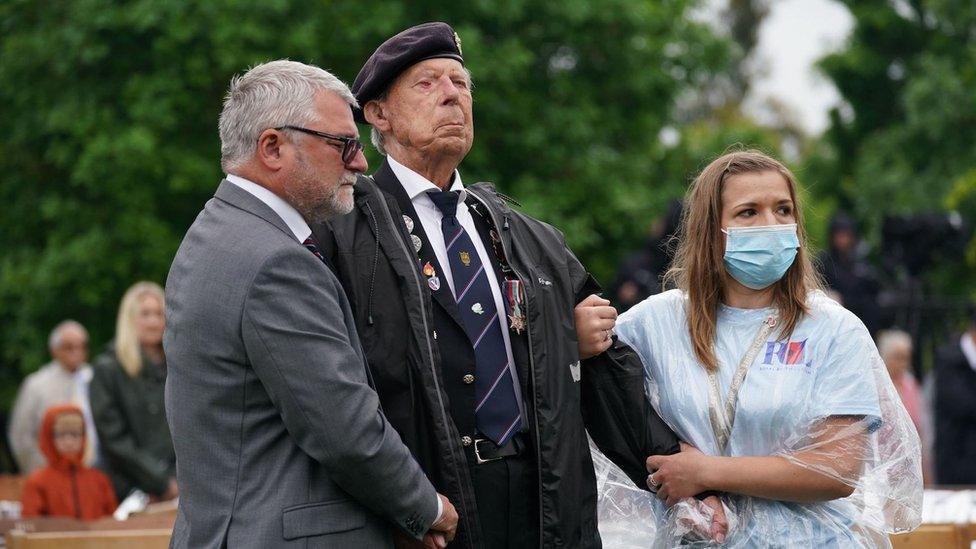
After months of lockdown, the National Memorial Arboretum event was the first chance for veterans to gather this year
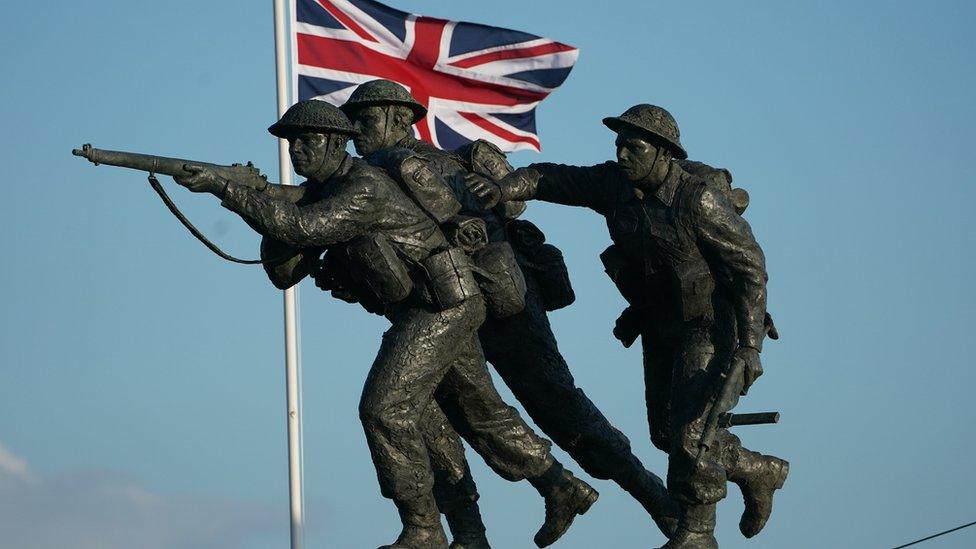
The bronze sculpture of three charging infantrymen by British sculptor David Williams-Ellis is part of the memorial site
There is also a monument dedicated to the memory of French civilians who died during the period.
The British Normandy Memorial had originally been due to open last September but it was postponed due to the pandemic.
Lord Richard Dannatt, the former head of the British army, said it would stand as an "an everlasting memorial to the greatest amphibious operation ever to have taken place in history".
"It was so important that it played a significant role in ending the Second World War and bringing peace and freedom to Europe," he told BBC Breakfast.
He added that the constructing the monument was the "right and proper thing to have done" to honour fallen servicemen and women, but that it "perhaps should have been done 30 or 40 years ago".
Related topics
- Published6 June 2020
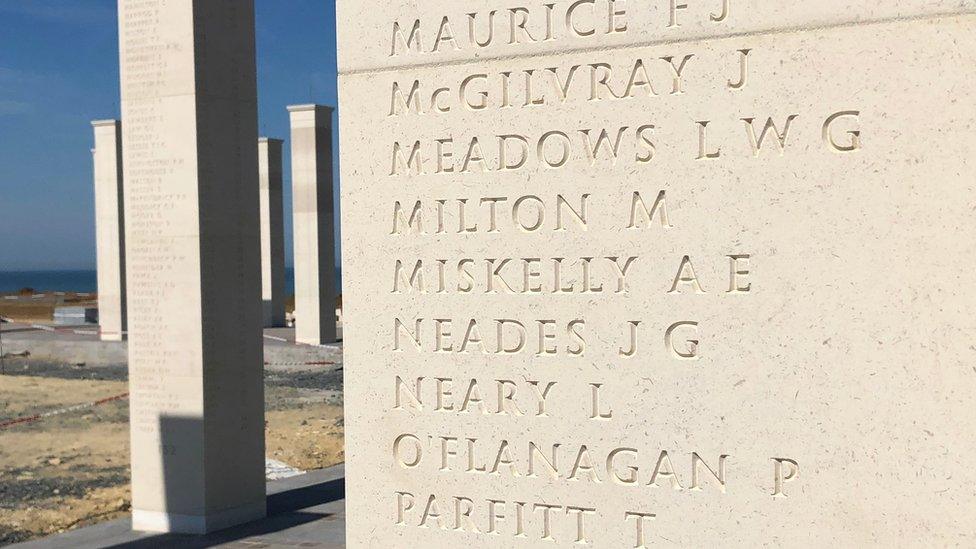
- Published3 March 2020
